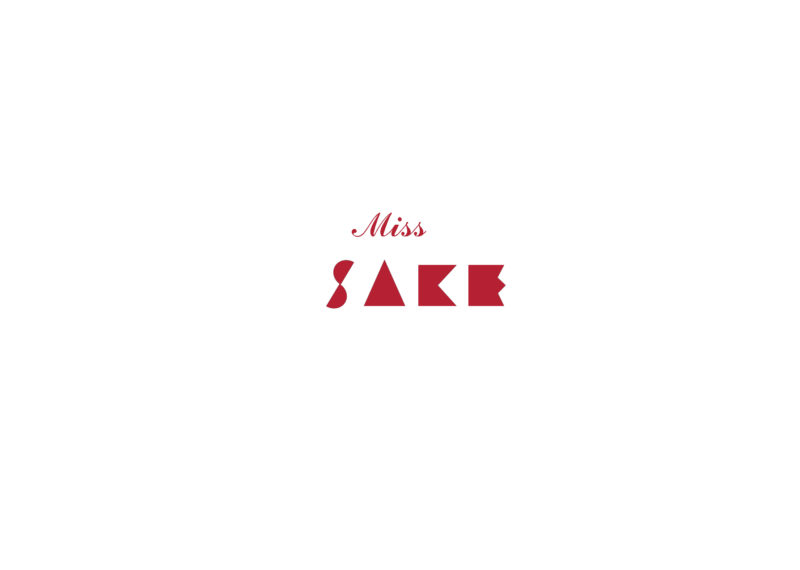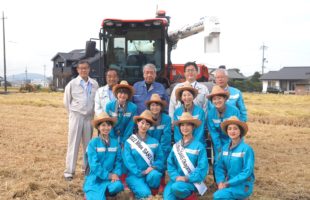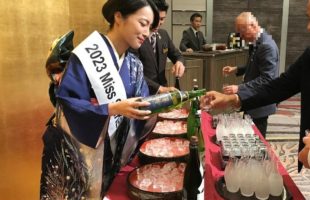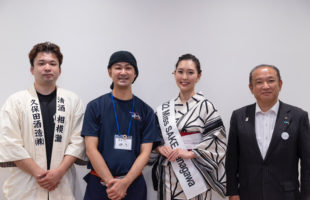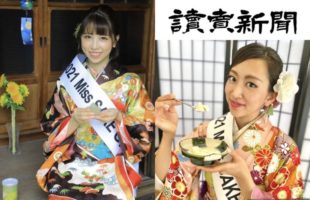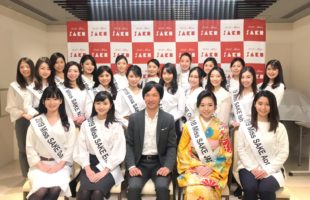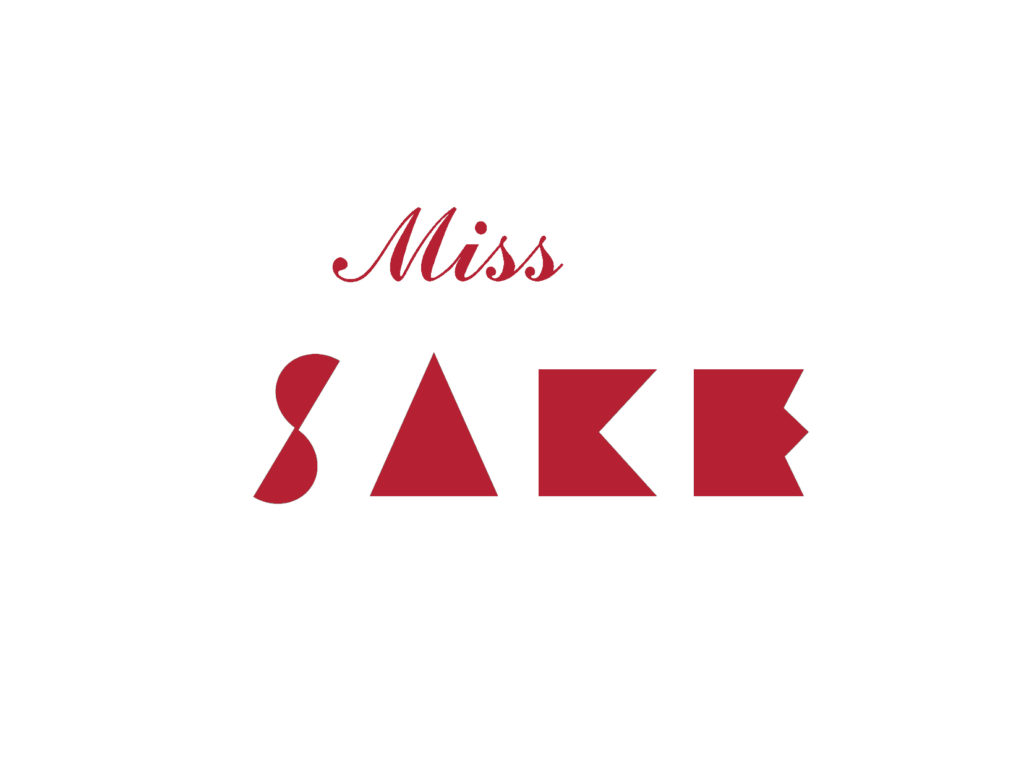今回のテーマは、『日本酒とワインの違い」。
日本酒は同じ醸造酒という共通点から、ワインと比較されることがよくあります。日本酒の原料はお米、ワインの原料はブドウ。両者の違いの一つに原料を思い浮かばれた方は多いのではないでしょうか。しかし、日本酒とワインの違いは原料だけではありません。それでは日本酒とワインの間には、一体どのような違いがあるのでしょうか。今回は造り方や楽しみ方に焦点を当て、両者の違いをご紹介させて頂きます。
以下に、本日学んだ日本酒の楽しみ方の日英対訳を記述させて頂きます。
英会話レッスンテーマ『日本酒とワインの違い(The Differences between Japanese Sake and Wine)』日英対訳
Unit 12. 日本酒とワインの違い
- 醸造過程
ワインは水を使わずに造られるため、原料のブドウの質が味を決めます。一方、日本酒はお米や水、酵母、造り手の技術など様々な要素で味が決まります。そのためお米が最高級品でなくても、水の質や杜氏の腕など、最終的な味わいを決めるその他の要素が素晴らしければ、美味しい日本酒が出来上がります。
醸造酒、蒸留酒、混成酒等、世界のお酒は、その製造方法によって大きく分類することができます。その中でも、日本酒とワインは同じ「醸造酒」というカテゴリーに分類され、基本的な製造方法は同じです。
「醸造酒」とは、穀物や果物を酵母の力でアルコール発酵させたお酒のことを指します。日本酒とワインは、この発酵の流れに大きな違いがあります。酵母がアルコール発酵するためには、糖分が必要です。ワインの原料であるブドウにはもともと糖分が含まれているため、酵母を加えるとそのまま発酵が進みます。これを「単発酵」と呼びます。
一方、日本酒の原料であるお米には、糖分が含まれていません。そのため、麹菌の力を借りて、米に含まれるデンプンを糖分に変化させる必要があります。そして、デンプンが変化した糖分を酵母の力でアルコール発酵させます。原料に含まれる糖分をそのまま発酵させる単発酵とは異なり、原料に含まれるデンプンを糖分に分解してから、酵母を加えてアルコール発酵させる方法を「複発酵」といいます。このように「糖化」と「発酵」の2つの工程が必要な発酵方法であることから複発酵と呼ばれます。
複発酵は「単行複発酵」と「並行複発酵」の2通りに分けられます。日本酒やワインと同じ「醸造酒」であるビールは原料に糖分が含まれていないため、デンプンの糖化と酵母によるアルコール発酵が別々に進みます。ビールの場合は、糖化と発酵の工程が別々のタンクで進行しますが、日本酒の場合は、同じタンクの中で同時に進んでいきます。前者を「単行複発酵」、後者を「並行複発酵」といいます。「並行複発酵」は、日本酒特有の発酵形式です。ワインやビールと比較すると、より複雑で繊細な発酵と言えます。
2. 楽しめる温度帯の幅
日本酒とワインの共通点として、一般的にストレートで飲むことが挙げられます。その中でも日本酒は、楽しめる温度帯の幅がもっとも広いお酒と言われています。ワインを温めてホットワインとして飲む文化もありますが、日本酒は5℃前後に冷やしても、人肌燗でも、60℃前後にあたためても美味しく飲むことができます。この温度帯の幅こそ日本酒が持つ魅力の一つであり、ワインとの決定的な違いです。
3. 酒器のバラエティ
ワインは専用のグラスで楽しむことが多いですが、日本酒には味わい・温度帯によって酒器が異なります。グラスのふくらみ具合によって香りや味の開き具合が、飲み口の大きさによって味の感じ方に変化が生じます。すっきりとした香りが華やかなタイプの日本酒は縦長のグラスで、芳醇な香りやお米の旨みが感じられるタイプの日本酒はふくらみのあるグラスで頂くと、味わいがより一層際立ちます。また、酒器の厚さでも味わいの感じ方が異なります。ガラスなどの薄い酒器はよりシャープに感じられ、陶器などの分厚い酒器で頂くと、角が取れたまろやかな味わいになります。同じ日本酒であっても、異なる温度帯や様々な酒器で頂くことで味わいの幅が広がり、そこからきっと日本酒の奥深さを感じられるでしょう。
味わいだけで判断すると、日本酒とワインはまったく違う種類のお酒だと思ってしまうかもしれません。しかし日本酒とワインはどちらも「醸造酒」であり、原料であるお米やブドウの魅力を最大限に活かした素晴らしいお酒なのです。
【英訳】Unit 12. The Differences between Japanese Sake and Wine
Japanese sake is often compared with wine in terms of fermented liquor. Japanese sake is made from rice and wine is made from grapes. Many people may know that the ingredients are different, so what else makes them different?
Wine is made without water, so the taste of wine depends on the quality of grapes. On the other hand, Japanese sake is composed of many elements such as rice, water, yeast and the brewer’s techniques. Even if the brewing rice is not of the highest quality, great sake can be created if the other factors such as water quality and brewers’ skills are great.
Liquors around the world can be classified according to the production method like fermented liquor, spirits, mixed liquor and so on. Even among those, sake and wine are classified into the same category “fermented liquors”. Basically they are brewed using the same brewing process.
“Fermented liquor” is made by fermenting grains and fruits depending on the power of yeast. There is a big difference in their brewing procedures. In the case of sake, sugar is required to complete alcohol fermentation using yeast. With wine, sugar is originally contained in grape, so alcoholic fermentation begins automatically when yeast is added. This is called “Single fermentation”.
On the other hand, fermenting rice does not contain sugar, so another process need to be done so that it changes the starch contained in the rice into sugar using aspergillus oryzae.And finally, you can carry out alcoholic fermentation with sugar made from starch using yeast.
You can call it “multiple fermentation” when the process of starch changing into sugar and sugar changing into alcohol occur separately.
By the way, beer, which is the same “fermented liquor” as Japanese sake and wine, does not contain sugar in the raw material, so starch saccharification and alcohol fermentation by yeast takes place separately.
In the case of beer, the saccharification and fermentation processes take place in separate tanks, while in the case of Japanese sake, the process occurs simultaneously in the same tank. The former is called “single double fermentation” and the latter is called “parallel double fermentation”.
“Parallel double fermentation” is a unique process. It might be more complex and delicate than the fermentation processes for wine and beer. When comparing the alcohol content, generally sake is 15-16 percent, while wine is about 10-14 percent. So, wine is a little lower compared to sake.
In addition, people basically drink sake and wine straight. However, sake has the widest temperature range. There is a culture to have hot wine, but sake can be drunk even if it is chilled to around 5 ℃ or warmed to near 60 ℃.
What is more, wine is often enjoyed in a special glass, but there are various types of cups for drinking Japanese sake. Recently, the number of restaurants that offer Japanese sake in wine glasses, is increasing.
Judging by taste alone, you might think that sake and wine are completely different types of alcohol. However, both sake and wine get the most out of rice and grapesas ingredients.
Please try sake at different temperatures and in drinking cups to find your favorite one!
今回のレッスンでの一番の気づきは、「海外の方に親しみを持っていただけるよう工夫する」ことです。
今回のレッスンでは、日本酒とワインの違いについて説明する練習をさせて頂きました。
Miss SAKEとして日々活動をさせていただく中で、海外の方とお話をさせていただく機会を多く頂戴しており、ほとんどの方がワインをよく飲むと仰っていました。ワインが身近な存在である海外の方に日本酒をもっと楽しんで頂くには、どうすれば良いのか。
実際私が多く頂いた質問は、
“How do you make Japanese sake?” “Is there any sake you recommend?”です。
海外の方に日本酒をわかりやすく説明するため、私はよく同じ醸造酒であるワインの造り方を例に出して説明していました。すると身近に感じて頂けたのか、海外の方の反応がとても良く日本酒に興味を持って頂くことができました。
その日から海外の方に日本酒のご提案をさせて頂く際は、ワインを意識しながらお話をさせて頂いております。お好みのワインの味わいを伺い、似た特徴を持つ日本酒のテイスティングをご提案させて頂くことや、様々な温度で味わうことができる日本酒独自の魅力もお伝えさせて頂いております。
また、今回のレッスンをご担当頂いたインストラクターの方は、日頃ウイスキーを嗜んでいらっしゃる方でしたので、ウイスキー同様、琥珀色でまろやかな味わいの古酒をおすすめさせて頂きました。
日本酒を身近に感じて頂くことで、これまでは遠い存在であった日本酒が海外の方の日常にそっと寄り添うものになるのではないか、そんな思いを胸に抱きながら今後も国内外に向けて日本酒のPRに励んで参りたいと思います。
Gaba様、この度は素晴らしいレッスンを誠にありがとうございました。
*他のレッスン様子は以下よりご覧いただけます。
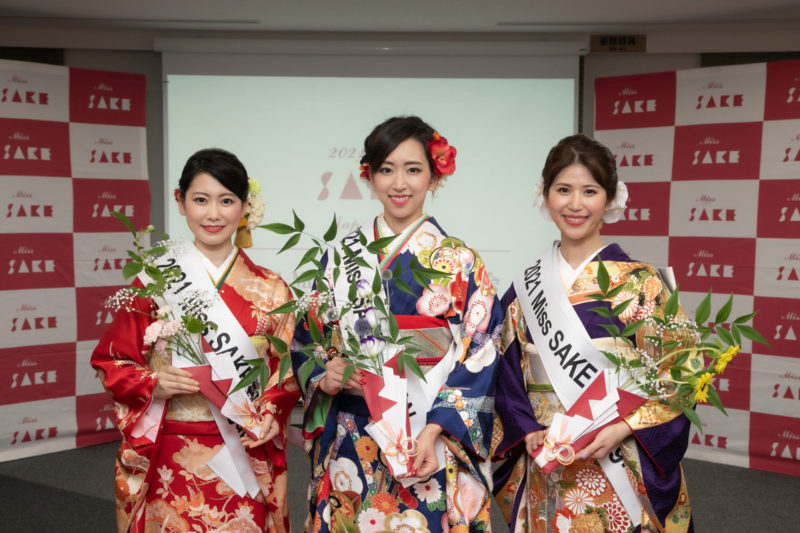
英会話Gaba × Miss SAKE Miss SAKE(ミス日本酒)にご協力を頂いている企業様の中に、以前よりご協力いただいている「英会話のGaba」様がございます。 過去には英語を学びながら、ミス日本酒と日本酒を愉しむ「日本酒女子会 in English」も開催させていただいております...
英会話Gaba × Miss SAKE Miss SAKE(ミス日本酒)にご協力を頂いている企業様の中に、以前よりご協力いただいている「英会話のGaba」様がございます。 過去には英語を学びながら、ミス日本酒と日本酒を愉しむ「日本酒女子会 in English」も開催させていただいております...
The theme for this time was “The Differences between Japanese Sake and Wine”.
[for English Speakers]
The theme for this time was “The Differences between Japanese Sake and Wine”.
I described what I learned this time below.
Unit 12. The Differences between Japanese Sake and Wine”.
Japanese sake is often compared with wine in terms of fermented liquor. Japanese sake is made from rice and wine is made from grapes. Many people may know that the ingredients are different, so what else makes them different?
Wine is made without water, so the taste of wine depends on the quality of grapes. On the other hand, Japanese sake is composed of many elements such as rice, water, yeast and the brewer’s techniques. Even if the brewing rice is not of the highest quality, great sake can be created if the other factors such as water quality and brewers’ skills are great.
Liquors around the world can be classified according to the production method like fermented liquor, spirits, mixed liquor and so on. Even among those, sake and wine are classified into the same category “fermented liquors”. Basically they are brewed using the same brewing process.
“Fermented liquor” is made by fermenting grains and fruits depending on the power of yeast. There is a big difference in their brewing procedures. In the case of sake, sugar is required to complete alcohol fermentation using yeast. With wine, sugar is originally contained in grape, so alcoholic fermentation begins automatically when yeast is added. This is called “Single fermentation”.
On the other hand, fermenting rice does not contain sugar, so another process need to be done so that it changes the starch contained in the rice into sugar using aspergillus oryzae.And finally, you can carry out alcoholic fermentation with sugar made from starch using yeast.
You can call it “multiple fermentation” when the process of starch changing into sugar and sugar changing into alcohol occur separately.
By the way, beer, which is the same “fermented liquor” as Japanese sake and wine, does not contain sugar in the raw material, so starch saccharification and alcohol fermentation by yeast takes place separately.
In the case of beer, the saccharification and fermentation processes take place in separate tanks, while in the case of Japanese sake, the process occurs simultaneously in the same tank. The former is called “single double fermentation” and the latter is called “parallel double fermentation”.
“Parallel double fermentation” is a unique process. It might be more complex and delicate than the fermentation processes for wine and beer. When comparing the alcohol content, generally sake is 15-16 percent, while wine is about 10-14 percent. So, wine is a little lower compared to sake.
In addition, people basically drink sake and wine straight. However, sake has the widest temperature range. There is a culture to have hot wine, but sake can be drunk even if it is chilled to around 5 ℃ or warmed to near 60 ℃.
What is more, wine is often enjoyed in a special glass, but there are various types of cups for drinking Japanese sake. Recently, the number of restaurants that offer Japanese sake in wine glasses, is increasing.
Judging by taste alone, you might think that sake and wine are completely different types of alcohol. However, both sake and wine get the most out of rice and grapesas ingredients.
Please try sake at different temperatures and in drinking cups to find your favorite one!
I will work hard to absorb many things in the next lesson.
GABA, thank you very much for this wonderful lesson.
*他のレッスン様子は以下よりご覧いただけます。

英会話Gaba × Miss SAKE Miss SAKE(ミス日本酒)にご協力を頂いている企業様の中に、以前よりご協力いただいている「英会話のGaba」様がございます。 過去には英語を学びながら、ミス日本酒と日本酒を愉しむ「日本酒女子会 in English」も開催させていただいております...
英会話Gaba × Miss SAKE Miss SAKE(ミス日本酒)にご協力を頂いている企業様の中に、以前よりご協力いただいている「英会話のGaba」様がございます。 過去には英語を学びながら、ミス日本酒と日本酒を愉しむ「日本酒女子会 in English」も開催させていただいております...

